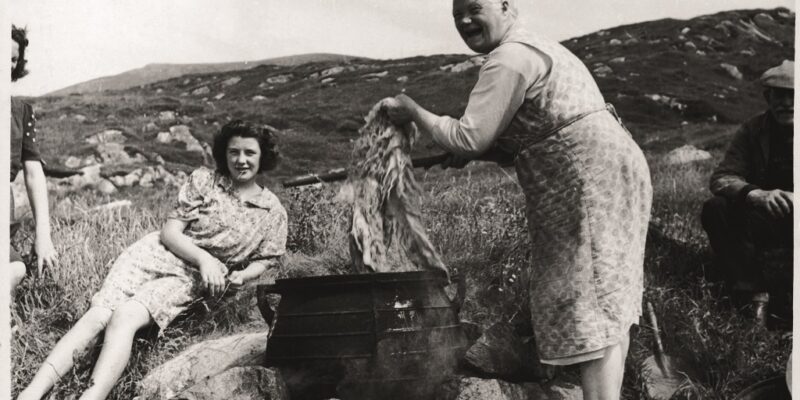Made only in the Outer Hebrides, Harris Tweed is a textile that calls to mind its location and is still produced using age-old techniques
MORE FROM SCOTLAND MAGAZINE
The Isle of Lewis & Harris is renowned for its awesome scenery: rugged coastlines – where you’ll find some of the most beautiful beaches in the world – bleak mountains and lunar landscapes, where you’ll find glistening rocks carved out by glaciers in the Ice Ages.
The colours throughout the landscape are equally spectacular – you’ll see vibrant blues reflecting the skies and sea, golden gorse, blinding white sand, the warm browns and greens of the moors and the purple heather and myriad wildflowers dancing against the verdant machair. All of these shades are incorporated into Harris Tweed, the island’s most famous export, along with the lustrous reds of the poppies, blush pink of clover and soft yellow of the buttercups.
The people in the Outer Hebrides of Scotland have woven Harris Tweed for centuries. It has long been renowned locally both for its practical and aesthetic properties, but everything changed 175 years ago when it was launched into a much wider market.
In 1846, Lady Dunmore, widow of the landowner of Harris, the Earl of Dunmore, had the clan tartan replicated by Harris weavers in tweed. The results proved so successful that she began marketing the tweed to her wealthy friends further afield and quickly established the island cloth with merchants across the country.
In 1909 the Harris Tweed Association was formed to ensure that the fabric could not be imitated or produced in inferior quality. It devised the now famous Orb trademark, which appears on every single Harris Tweed item to prove that it is made from genuine Harris Tweed. Finally, in 1993, an Act of Parliament ensured that no other fabric could call itself Harris Tweed and brought into being the Harris Tweed Authority, a new statutory body, which replaced the Harris Tweed Association, becoming ‘Guardians of the Orb’.
In accordance with the Act, Harris Tweed must be “Handwoven by the islanders at their homes in the Outer Hebrides, finished in the Outer Hebrides, and made from pure virgin wool dyed and spun in the Outer Hebrides.” Harris Tweed is the only fabric in the world protected by an Act of Parliament, with the Act ensuring that all cloth certified with the Harris Tweed Orb symbol complies with this definition and the legislation – alongside the work of the Harris Tweed Authority – allows the safeguarding of the Harris Tweed name, quality and reputation. The Harris Tweed Authority monitors all fabric on a daily basis and every 50 metres of fabric is inspected and approved before being stamped by hand with the Orb trademark.

Weaver Kenny Maclennan, 65, has been working in the industry most of his life. “My mother was a weaver, so I used to watch and learn from her,” he says. “Weaving was also taught in Shawbost School and I’ve also worked in Harris Tweed mills,which gives you a rounded understanding of the process.”
Kenny can possibly almost do this with his eyes shut, but does agree that weaving is a complex process. “The two looms, single and double, have their quirks which you must be able to repair and adjust. Critical to weaving is setting up the yarn in the loom, the tie-in, and making sure the 1,300+ threads are all in the right place.”
And Kenny is right to ensure he sticks to the correct processes. “We oversee every step of the production process,” says Lorna Macaulay, CEO of the Harris Tweed Authority. “The fleece used in the manufacture of Harris Tweed is sourced mainly from mainland Scotland, with the clip from island flock collected and added. It’s the wool that is dyed, rather than the yarn. That’s reflected in the colours – some of the yarns will have up to eight colours – and its 100 per cent natural fibres. Harris Tweed is extremely important, both in keeping its unique properties and remaining a cottage industry.”
This is an extract. Read the full feature in the January/February 2021 issue of Scotland, out on 18th December
MORE FROM SCOTLAND MAGAZINE

SCOTLAND MAGAZINE
Published six times a year, every issue of Scotland showcases its stunning landscapes and natural beauty, and delves deep into Scottish history. From mysterious clans and famous Scots (both past and present), to the hidden histories of the country’s greatest castles and houses, Scotland‘s pages brim with the soul and secrets of the country.
Scotland magazine captures the spirit of this wild and wonderful nation, explores its history and heritage and recommends great places to visit, so you feel at home here, wherever you are in the world.